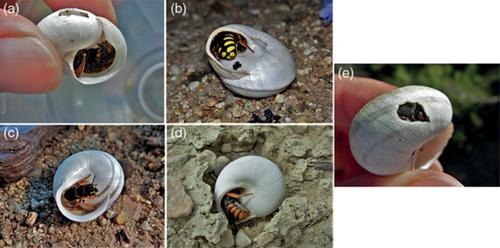当前位置:
X-MOL 学术
›
Entomol. Sci.
›
论文详情
Our official English website, www.x-mol.net, welcomes your
feedback! (Note: you will need to create a separate account there.)
Where and why? Bees, snail shells and climate: Distribution of Rhodanthidium (Hymenoptera: Megachilidae) in the Iberian Peninsula
Entomological Science ( IF 0.7 ) Pub Date : 2020-05-27 , DOI: 10.1111/ens.12420 Daniel Romero 1 , Concepción Ornosa 1 , Pablo Vargas 2
Entomological Science ( IF 0.7 ) Pub Date : 2020-05-27 , DOI: 10.1111/ens.12420 Daniel Romero 1 , Concepción Ornosa 1 , Pablo Vargas 2
Affiliation

|
Species distribution patterns are widely studied through species distribution models (SDMs), focusing mostly on climatic variables. Joint species distribution models (JSDMs) allow inferring if other factors (biotic interactions, shared phylogenetic history or other unmeasured variables) can also have an influence on species distribution. We identified current distributional areas and optimal suitability areas of three species of the solitary snail‐shell bee Rhodanthidium (Hymenoptera: Megachilidae), and their host gastropod species in the Iberian Peninsula. We undertook SDMs using Maxent software, based on presence points and climatic variables. We also undertook JSDMs for the bees and the snails to infer if co‐occurrence could be a result of biotic interactions. We found that the three bee species: (1) use at least five different species of Mediterranean snails; (2) use empty shells not only for nesting but also for sheltering when there is adverse weather and during the night; (3) have their most suitable areas in the eastern and southern Iberian Peninsula, mostly on limestone areas; and (4) have their optimal range under Mediterranean climatic values for the studied variables. There is positive co‐occurrence of Rhodanthidium with the gastropod species, especially with the snail Sphincterochila candidissima. The contribution of the environmental component to the co‐occurrence is less than that of the residual component in those cases, suggesting that: (i) the use of biotic resources (between Rhodanthidium and the gastropod species); (ii) shared phylogenetic history (between R. septemdentatum and R. sticticum); or (iii) unmeasured variables are largely responsible for co‐occurrence.
中文翻译:

在哪里以及为什么?蜜蜂、蜗牛壳和气候:伊比利亚半岛的红花(膜翅目:巨齿科)的分布
通过物种分布模型 (SDM) 广泛研究物种分布模式,主要关注气候变量。联合物种分布模型 (JSDM) 允许推断其他因素(生物相互作用、共享系统发育历史或其他未测量的变量)是否也会对物种分布产生影响。我们确定了三种独居蜗牛壳蜂 Rhodanthidium(膜翅目:Megachilidae)及其寄主腹足类动物在伊比利亚半岛的当前分布区和最佳适宜区。我们使用 Maxent 软件根据存在点和气候变量进行 SDM。我们还对蜜蜂和蜗牛进行了 JSDM,以推断共同发生是否可能是生物相互作用的结果。我们发现了三种蜜蜂:(1) 使用至少五种不同种类的地中海蜗牛;(2) 空壳不仅用于筑巢,而且在恶劣天气和夜间用于避风;(3) 在伊比利亚半岛东部和南部有他们最适合的地区,多在石灰岩地区;(4) 在地中海气候值下对研究变量具有最佳范围。Rhodanthidium 与腹足类物种,特别是与蜗牛 Sphincterochila candidissima 有阳性共存。在这些情况下,环境成分对共生的贡献小于残留成分的贡献,这表明:(i) 生物资源的利用(在红花属和腹足类物种之间);(ii) 共享的系统发育史(在 R. septemdentatum 和 R. sticticum 之间);
更新日期:2020-05-27
中文翻译:

在哪里以及为什么?蜜蜂、蜗牛壳和气候:伊比利亚半岛的红花(膜翅目:巨齿科)的分布
通过物种分布模型 (SDM) 广泛研究物种分布模式,主要关注气候变量。联合物种分布模型 (JSDM) 允许推断其他因素(生物相互作用、共享系统发育历史或其他未测量的变量)是否也会对物种分布产生影响。我们确定了三种独居蜗牛壳蜂 Rhodanthidium(膜翅目:Megachilidae)及其寄主腹足类动物在伊比利亚半岛的当前分布区和最佳适宜区。我们使用 Maxent 软件根据存在点和气候变量进行 SDM。我们还对蜜蜂和蜗牛进行了 JSDM,以推断共同发生是否可能是生物相互作用的结果。我们发现了三种蜜蜂:(1) 使用至少五种不同种类的地中海蜗牛;(2) 空壳不仅用于筑巢,而且在恶劣天气和夜间用于避风;(3) 在伊比利亚半岛东部和南部有他们最适合的地区,多在石灰岩地区;(4) 在地中海气候值下对研究变量具有最佳范围。Rhodanthidium 与腹足类物种,特别是与蜗牛 Sphincterochila candidissima 有阳性共存。在这些情况下,环境成分对共生的贡献小于残留成分的贡献,这表明:(i) 生物资源的利用(在红花属和腹足类物种之间);(ii) 共享的系统发育史(在 R. septemdentatum 和 R. sticticum 之间);







































 京公网安备 11010802027423号
京公网安备 11010802027423号